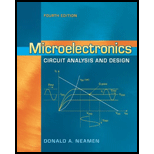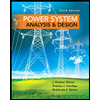
Microelectronics: Circuit Analysis and Design
4th Edition
ISBN: 9780073380643
Author: Donald A. Neamen
Publisher: McGraw-Hill Companies, The
expand_more
expand_more
format_list_bulleted
Question
Chapter 11, Problem 11.35P
a.
To determine
The design parameters of the circuit to meet the specifications.
b.
To determine
The value of
c.
To determine
Find the
Expert Solution & Answer
Want to see the full answer?
Check out a sample textbook solution
Students have asked these similar questions
Please work out
Find Vfinal when Vs
up
and Vs V. Which LED will light
in each case? Red or Green? Justify your answers. Fill the
table below.
Vs
8 ΚΩ
Vos
Χρι
+
3 ΚΩ
www
6 ΚΩ
ww
4 ΚΩ Yo
www
Vo
Vec-12 V
Nol
V final
Vm
w
3 ΚΩ
5 V
38 ΚΩ
R= 1 kQ
V
-12 V
Red LED
Green
LED
Vs
Vo
Vfinal
Which LED is ON?
V
Circuits help please solve and explain. Question in images provided
Chapter 11 Solutions
Microelectronics: Circuit Analysis and Design
Ch. 11 - The circuit parameters for the differential...Ch. 11 - Consider the de transfer characteristics shown in...Ch. 11 - Prob. 11.1CSPCh. 11 - Consider the diff-amp described in Example 11.3 ....Ch. 11 - Prob. 11.4EPCh. 11 - Prob. 11.1TYUCh. 11 - Prob. 11.2TYUCh. 11 - Assume the differential-mode gain of a diff-amp is...Ch. 11 - Prob. 11.5EPCh. 11 - Consider the diff-amp shown in Figure 11.15 ....
Ch. 11 - Prob. 11.7EPCh. 11 - Prob. 11.4TYUCh. 11 - Prob. 11.5TYUCh. 11 - The parameters of the diff-amp shown in Figure...Ch. 11 - For the differential amplifier in Figure 11.20,...Ch. 11 - The parameters of the circuit shown in Figure...Ch. 11 - The circuit parameters of the diff-amp shown in...Ch. 11 - Consider the differential amplifier in Figure...Ch. 11 - The diff-amp in Figure 11.19 is biased at IQ=100A....Ch. 11 - Prob. 11.10TYUCh. 11 - The diff-amp circuit in Figure 11.30 is biased at...Ch. 11 - Prob. 11.11EPCh. 11 - Prob. 11.12EPCh. 11 - Prob. 11.11TYUCh. 11 - Prob. 11.12TYUCh. 11 - Redesign the circuit in Figure 11.30 using a...Ch. 11 - Prob. 11.14TYUCh. 11 - Prob. 11.15TYUCh. 11 - Prob. 11.16TYUCh. 11 - Prob. 11.17TYUCh. 11 - Consider the Darlington pair Q6 and Q7 in Figure...Ch. 11 - Prob. 11.14EPCh. 11 - Consider the Darlington pair and emitter-follower...Ch. 11 - Prob. 11.19TYUCh. 11 - Prob. 11.15EPCh. 11 - Consider the simple bipolar op-amp circuit in...Ch. 11 - Prob. 11.17EPCh. 11 - Define differential-mode and common-mode input...Ch. 11 - Prob. 2RQCh. 11 - From the dc transfer characteristics,...Ch. 11 - What is meant by matched transistors and why are...Ch. 11 - Prob. 5RQCh. 11 - Explain how a common-mode output signal is...Ch. 11 - Define the common-mode rejection ratio, CMRR. What...Ch. 11 - What design criteria will yield a large value of...Ch. 11 - Prob. 9RQCh. 11 - Define differential-mode and common-mode input...Ch. 11 - Sketch the de transfer characteristics of a MOSFET...Ch. 11 - Sketch and describe the advantages of a MOSFET...Ch. 11 - Prob. 13RQCh. 11 - Prob. 14RQCh. 11 - Describe the loading effects of connecting a...Ch. 11 - Prob. 16RQCh. 11 - Prob. 17RQCh. 11 - Prob. 18RQCh. 11 - (a) A differential-amplifier has a...Ch. 11 - Prob. 11.2PCh. 11 - Consider the differential amplifier shown in...Ch. 11 - Prob. 11.4PCh. 11 - Prob. D11.5PCh. 11 - The diff-amp in Figure 11.3 of the text has...Ch. 11 - The diff-amp configuration shown in Figure P11.7...Ch. 11 - Consider the circuit in Figure P11.8, with...Ch. 11 - The transistor parameters for the circuit in...Ch. 11 - Prob. 11.10PCh. 11 - Prob. 11.11PCh. 11 - The circuit and transistor parameters for the...Ch. 11 - Prob. 11.13PCh. 11 - Consider the differential amplifier shown in...Ch. 11 - Consider the circuit in Figure P11.15. The...Ch. 11 - Prob. 11.16PCh. 11 - Prob. 11.17PCh. 11 - For the diff-amp in Figure 11.2, determine the...Ch. 11 - Prob. 11.19PCh. 11 - Prob. D11.20PCh. 11 - Prob. 11.21PCh. 11 - The circuit parameters of the diff-amp shown in...Ch. 11 - Consider the circuit in Figure P11.23. Assume the...Ch. 11 - Prob. 11.24PCh. 11 - Consider the small-signal equivalent circuit of...Ch. 11 - Prob. D11.26PCh. 11 - Prob. 11.27PCh. 11 - A diff-amp is biased with a constant-current...Ch. 11 - The transistor parameters for the circuit shown in...Ch. 11 - Prob. D11.30PCh. 11 - For the differential amplifier in Figure P 11.31...Ch. 11 - Prob. 11.32PCh. 11 - Prob. 11.33PCh. 11 - Prob. 11.34PCh. 11 - Prob. 11.35PCh. 11 - Prob. 11.36PCh. 11 - Consider the normalized de transfer...Ch. 11 - Prob. 11.38PCh. 11 - Consider the circuit shown in Figure P 11.39 . The...Ch. 11 - Prob. 11.40PCh. 11 - Prob. 11.41PCh. 11 - Prob. 11.42PCh. 11 - Prob. 11.43PCh. 11 - Prob. D11.44PCh. 11 - Prob. D11.45PCh. 11 - Prob. 11.46PCh. 11 - Consider the circuit shown in Figure P 11.47 ....Ch. 11 - Prob. 11.48PCh. 11 - Prob. 11.49PCh. 11 - Prob. 11.50PCh. 11 - Consider the MOSFET diff-amp with the...Ch. 11 - Consider the bridge circuit and diff-amp described...Ch. 11 - Prob. D11.53PCh. 11 - Prob. 11.54PCh. 11 - Prob. 11.55PCh. 11 - Consider the JFET diff-amp shown in Figure P11.56....Ch. 11 - Prob. 11.57PCh. 11 - Prob. 11.58PCh. 11 - Prob. D11.59PCh. 11 - The differential amplifier shown in Figure P 11.60...Ch. 11 - Prob. 11.61PCh. 11 - Consider the diff-amp shown in Figure P 11.62 ....Ch. 11 - Prob. 11.63PCh. 11 - The differential amplifier in Figure P11.64 has a...Ch. 11 - Prob. 11.65PCh. 11 - Consider the diff-amp with active load in Figure...Ch. 11 - The diff-amp in Figure P 11.67 has a...Ch. 11 - Consider the diff-amp in Figure P11.68. The PMOS...Ch. 11 - Prob. 11.69PCh. 11 - Prob. 11.70PCh. 11 - Prob. D11.71PCh. 11 - Prob. D11.72PCh. 11 - An all-CMOS diff-amp, including the current source...Ch. 11 - Prob. D11.74PCh. 11 - Consider the fully cascoded diff-amp in Figure...Ch. 11 - Consider the diff-amp that was shown in Figure...Ch. 11 - Prob. 11.77PCh. 11 - Prob. 11.78PCh. 11 - Prob. 11.79PCh. 11 - Prob. 11.80PCh. 11 - Consider the BiCMOS diff-amp in Figure 11.44 ,...Ch. 11 - The BiCMOS circuit shown in Figure P11.82 is...Ch. 11 - Prob. 11.83PCh. 11 - Prob. 11.84PCh. 11 - For the circuit shown in Figure P11.85, determine...Ch. 11 - The output stage in the circuit shown in Figure P...Ch. 11 - Prob. 11.87PCh. 11 - Consider the circuit in Figure P11.88. The bias...Ch. 11 - Prob. 11.89PCh. 11 - Consider the multistage bipolar circuit in Figure...Ch. 11 - Prob. D11.91PCh. 11 - Prob. 11.92PCh. 11 - For the transistors in the circuit in Figure...Ch. 11 - Prob. 11.94PCh. 11 - Prob. 11.95PCh. 11 - Prob. 11.96PCh. 11 - Consider the diff-amp in Figure 11.55 . The...Ch. 11 - The transistor parameters for the circuit in...
Knowledge Booster
Learn more about
Need a deep-dive on the concept behind this application? Look no further. Learn more about this topic, electrical-engineering and related others by exploring similar questions and additional content below.Similar questions
- + V 6.2 A 1.2 A S R 4 Ω Find the source voltage Vs 0.8 Aarrow_forwardDetermine i(t) for t≥ 0 given that the circuit below had been in steady state for a long time prior to t = 0. Also, I₁ = 1 5 A, R₁ =22, R2 =10 Q2, R3 = 32, R4 =7 2, and L=0.15 H. Also fill the table. m L ww R2 t = 0 R₁ 29 R3 R4 Time 0 iL(t) 0 8arrow_forwardPlease help explain this problemarrow_forward
- + P = 16 W w w P = 8 W I R₁ R2 E = RT=322 1- Determine R1, R2, E ΙΩarrow_forward+ 30 V = - 20 V + R 2- Use KVL to find the voltage V - V + + 8 Varrow_forwardFind the Thévenin equivalent circuit for the portions of the networks in Figure external to the elements between points a and b. a R₁ 2002 I = 0.1 A 0° Xc : 32 Ω R2 = 6802 20 Ω фъarrow_forward
- Find the Norton equivalent circuit for the network external to the elements between a and b for the networks in Figure. E1 = 120 V Z 0° R ww 10 Ω Xc XL · 000 802 802 ① I = 0.5 AZ 60° ZL barrow_forwardUsing superposition, determine the current through inductance XL for each network in Figure I = 0.3 A 60° XL 000 802 XC 502 Ω E 10 V0° =arrow_forwardFind the Thévenin equivalent circuit for the portions of the networks in Figure external to the elements between points a and b. E = 20 VZ0° + R ww 2 ΚΩ Хо XL 000 6ΚΩ 3 ΚΩ b RLarrow_forward
- What percentage of the full-load current of a thermally protected continuous-duty motor of more than one Hp can the trip current be, if the full-load current is 15 amperes? Ο 122 Ο 140 156 O 170arrow_forwardQ3arrow_forwardIn thinkercad can you make a parallel series circuit with a resistors and a voltage source explain how the voltage and current moves through the circuit, and explaining all the components, and if you were to break the circuit to find the current how would you do that? Please show visuals if possible.arrow_forward
arrow_back_ios
SEE MORE QUESTIONS
arrow_forward_ios
Recommended textbooks for you
 Power System Analysis and Design (MindTap Course ...Electrical EngineeringISBN:9781305632134Author:J. Duncan Glover, Thomas Overbye, Mulukutla S. SarmaPublisher:Cengage Learning
Power System Analysis and Design (MindTap Course ...Electrical EngineeringISBN:9781305632134Author:J. Duncan Glover, Thomas Overbye, Mulukutla S. SarmaPublisher:Cengage Learning

Power System Analysis and Design (MindTap Course ...
Electrical Engineering
ISBN:9781305632134
Author:J. Duncan Glover, Thomas Overbye, Mulukutla S. Sarma
Publisher:Cengage Learning
CMOS Tech: NMOS and PMOS Transistors in CMOS Inverter (3-D View); Author: G Chang;https://www.youtube.com/watch?v=oSrUsM0hoPs;License: Standard Youtube License